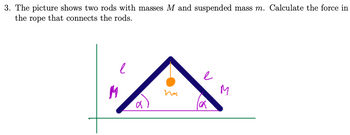Question

Transcribed Image Text:3. The picture shows two rods with masses M and suspended mass m. Calculate the force in
the rope that connects the rods.
M
е
a
mi
e
lak
M
Expert Solution
This question has been solved!
Explore an expertly crafted, step-by-step solution for a thorough understanding of key concepts.
Step by stepSolved in 3 steps with 2 images

Knowledge Booster
Similar questions
- Draw a physical model and associated FBD of the cable supporting a street lamp. Assume that the weight of the cable is negligible compared to the lamp.arrow_forward5. Determine the force exerted by the cable at B and the reaction at support A for the bar shown. You may assume the bar is massless for the analysis. Write your answers using 3 significant digits. y A 900 N Cable B 22° C 40° 300 mm 250 mmarrow_forwardThe L1 and L2 re the lengths of the rope that supports the masses M1₁ and M2, respectively. The hanging masses are placed at the end of a horizontal bar whose length is R₁ + R₂, as shown. R₁ R₂ L₁ M₁ R1L1= R242 L₁ L2 and R₁ = R₂ L₁ L2 and M₁ = M2 R₂ and M₁ = M2 L₂ The horizontal bar in the figure will remain horizontal if: OR₁ M₂arrow_forward
- In the figure, a horizontal scaffold, of length 2.26 m and uniform mass 59.9 kg, is suspended from a building by two cables. The scaffold has dozens of paint cans stacked on it at various points. The total mass of the paint cans in 79.9 kg. The tension in the cable at the right is 739 N. How far horizontally from that cable is the center of mass of the system of paint cans? Number i Units marrow_forward3arrow_forwardi'm doing chapter 4 problem 12p in the college physics 11th edition text book. On bartleby it says that "total force along the x axis is fx= f1sin30degrees - f2sin10degrees" my question is that wouldnt it be the cosine since it is the x axis and not sin?? i put a image belowarrow_forward
- 23. The diagram below shows a door viewed from above. Much to their parent's annoyance, two kids are fighting over opening/closing the door - do not do this at home! (Note that the door does not have a latch exerting any force on it) The diagram below shows the force that child A is exerting on the door: of magnitude F in the south direction, a distance of L/3 from the hinge. N wefe W E S F hinge L/3 L Child B decides to exert a force on the edge of the door, as far as possible from the hinge. What is the magnitude and direction of the force that child B must exert if the door does not move? A) Force of magnitude F in the north direction B) Force of magnitude F in the east direction C) Force of magnitude F/3 in the north direction D) Force of magnitude F/3 in the west directionarrow_forwardebAssign 110 N 40 ASK YOUR TEACHER 3. DETAILS SERCP11 4.7.P.065.MI. Objects with masses m, = 15.0 kg and m, = 8.0 kg are connected by a light string that passes over a frictionless pulley as in the figure below. If, when the system starts from rest, m, falls 1.00 m in 1.78 s, determine the coefficient of kinetic friction between m, and the table. 4. DETAILS SERCP11 5.2.OP.015. ASK YOUR TEACHER A 7.80 g bullet is initially moving at 620 m/s just before it penetrates a block of wood to a depth of 5.80 cm. (a) What is the magnitude of the average frictional force (in N) that is exerted on the bullet while it is moving through the block of wood? Use work and energy considerations to obtain your answer. (b) Assuming the frictional force is constant, how much time (in s) elapses between the moment the bullet enters the block of wood and the moment it stops moving?arrow_forwardWhat is the force magnitude on the first wire in the figure? (Figure 1) Express your answer using two significant figures. F = What is the force magnitude on the second wire in the figure? F = What is the force magnitude on the third wire in the figure? F =arrow_forward
arrow_back_ios
arrow_forward_ios